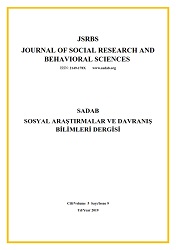Kısmi En Küçük Kareler Yapısal Eşitlik Modellemesi (PLS-SEM) ve Bir Uygulama
Partial Least Squares Structural Equation Modeling (PLS-SEM) and an Application
Author(s): Fatma Sönmez ÇakirSubject(s): Economy, Methodology and research technology
Published by: SD Yayınevi
Keywords: Structural Equation Modeling; PLS-SEM; CB-SEM; Multivariate statistical methods; Factor analysis; Mediation Effect;
Summary/Abstract: The methods used in statistical analysis can be examined as univariate and multivariate methods. The use and application of univariate methods is simple. Multivariate methods are more complex and difficult to implement. Multivariate analysis; used to analyze two or more variables at the same time. These analysis methods can be divided into first generation and second generation analysis methods. Clustering analysis, Explanatory-Confirmatory Factor Analysis, Multidimensional Scaling, Variance Analysis, Logistic Regression, Multiple Regression primary generation for this distinction; Partial Least Squares Structural Equation Modeling (PLSSEM) and Covariance Based Structural Equation Modeling (CB-SEM) are among the second generation techniques. In this study, information about Partial Least Squares Structural Equation Modeling (PLS-SEM), which is a second generation analysis technique, is given and an application is illustrated. The PLS-SEM model is a newly created model, which is frequently seen in the current literature and can be applied in many fields of Social Sciences. It has an advantageous structure from the covariance based SEM models used. One of the most important advantages is the ability to work with small samples and generation results. It can also be used in Reflective and Formative models. In the study, these advantages and some disadvantages of the model are mentioned and comprehensive information about how to interpret the results is presented. The implementation steps were performed in the SmartPLS 3.2 program and presented in tables with their comments.
Journal: Sosyal Araştırmalar ve Davranış Bilimleri
- Issue Year: 5/2019
- Issue No: 9
- Page Range: 111-128
- Page Count: 18
- Language: Turkish

